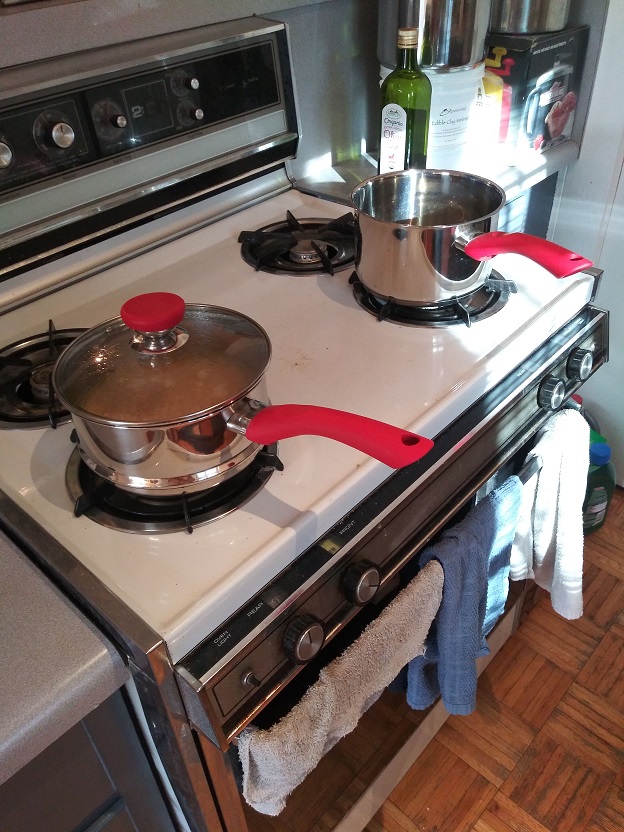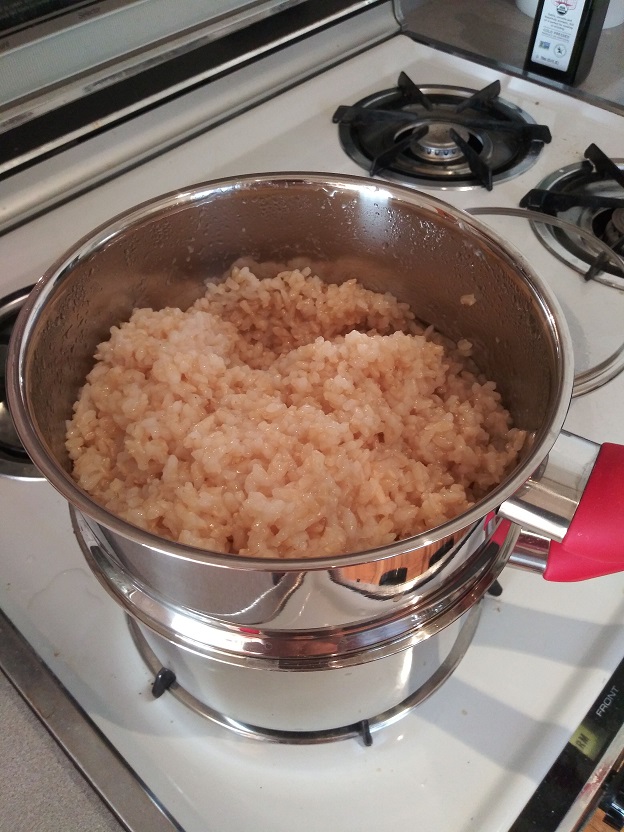Link to Macy's and other sellers of double boilers.
The one I bought a few months ago.
NOTE: not all double boilers come with a steamer section.
I wrote this item because when I did a google.com search for "cooking rice in a double boiler", all that came up at the top of the page was an item about using a steamer to cook rice, though "double-boiler" was mentioned for no apparent reason in that item.
The main advantage of cooking rice, other starchy grain foods, or other stickable foods in a double boiler is that you don't have to stir it much or even watch over it or even worry about the amount of water in the top section. (We do have to worry about the amount of water in the bottom section if cooking is to take place for a long time.)
NOTE: I'm NOT talking about steaming the rice. I'm talking about cooking the rice in a double boiler normally. This is also the best and easiest way to cook any starchy grain foods, such as grits, polenta, or cream of wheat (farina) since you don't have to stand there and stir it except during the initial heating of the upper section to a full boil directly over the burner.
Is a double boiler a "slow cooker"? Yes. A double boiler works similarly to a "crock pot" or "slow cooker" and precisely maintains a temperature of 212 degrees F.(at sea level), but will eventually run out of water usually in the lower section which could create a disaster.
What's the difference between a double boiler and a slow cooker? For one thing, with a double boiler, normally the upper section containing food is brought to a full boil for a second before placing over the lower section to finish at minimum temperature. Therefore, a double boiler normally cooks considerably faster than a slow cooker.
Note that as we go up in altitude, the boiling point of water goes down regardless of the type of boiler being used. This means the cooking temperature of the double boiler (or any boiling of water in any type of pot) will also go down accordingly, lengthening the time needed to cook anything. What will be the temperature of any water boiling in Denver, Colorado? (One mile high.)
Needed items:
- Double boiler, such as can be purchased from Macy's for about $25 to $75. I found a stainless steel one on sale from Macy's online for about $30. Double boilers are very rare, but highly prized.
- Ratio of rice to water: about 2 and 1/4 to 1. Slightly more water might work better than 2 to 1 since there's less chance of the rice being under-moistened. Using more water than the 2 to 1 ratio will allow the rice to fully plump up and be softer. You might even try 3 to 1.
Both Sections Heated up Separately at First.Over one burner, combine the rice and water with a little olive oil in the top section of the double boiler, then place the lid on it as it heats up. Place on stove directly over a burner or "eye". Stir occasionally but stir more often as it nears the boiling point. Meanwhile, using another burner, start heating the lower part of the double boiler containing just water - about 2 inches of water or more as needed.
At the beginning, both the top section containing rice and water with the lid on it are being initially heated up (and stirred) to a full boil on one burner, along with the lower section containing only water also being heated up on another burner. At the beginning, two burners are being used. There's usually no lid over the lower section since there's only one lid that comes with each double boiler. The lower section will usually come to a full boil before the upper section.
When the lower part containing only water comes to a boil, cut the heat down to the lowest setting to maintain boiling as you concentrate on initially warming the upper part with the rice and water to a full boil as you stir it to prevent sticking. Once the upper part containing rice and water comes to a full boil, remove from that burner and place the upper part covered by the lid over the lower part, and lower the heat to minimum-boil. Stir once or as many times as you like.
WARNING: once the top section has been brought to a full boil and placed over the lower section set to minimum boil, do not try to speed up the cooking process by increasing the heat of the lower section above minimum-boil, which is usually almost fully off. Greatly turning up the heat of the lower section above minimum boil does not increase the cooking temperature! Also, make sure you don't cut off the flame accidentally, possibly creating an explosion!
Place the Upper Section over the Lower Section.
This is what a double boiler looks like in action.Cut off the burner that is no longer being used.
At this point, you're only using one burner now with the double boiler at minimum heat setting. Just wait until it's fully cooked, then stir it again. You can also stir it before it's fully cooked, but that's not really necessary since it can't possibly burn or stick. The olive oil (or other oil) will prevent it from sticking also.
At it cooks, you can concentrate on other tasks while the double-boiler does its job without much of any need to stir or look over it. The amount of water added to the rice will determine the amount of time needed. The more time needed, the more water should've been added to the lower section. If necessary, add more water to the lower section; but this should not be necessary.
If you need much more time, you should've used a crock-pot or slow cooker.
FINISHED RICE IN THE DOUBLE BOILER.WARNING: once the top section has been brought to a full boil and placed over the lower section set to minimum boil, do not try to speed up the cooking process by increasing the heat of the lower section above minimum-boil, which is usually almost fully off. Greatly turning up the heat of the lower section above minimum boil does not increase the temperature! Also, make sure you don't cut off the flame accidentally, possibly creating an explosion!


